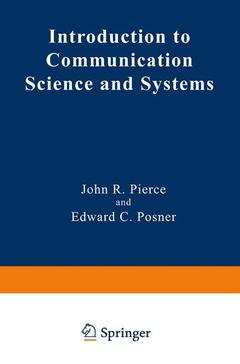Description
Introduction to Communication Science and Systems, Softcover reprint of the original 1st ed. 1980
Applications of Communications Theory Series
Authors: Pierce John R., Posner Edward C.
Language: English
Approximative price 158.24 €
In Print (Delivery period: 15 days).
Add to cart
Publication date: 05-2013
394 p. · 15.5x23.5 cm · Paperback
394 p. · 15.5x23.5 cm · Paperback
Description
/li>Contents
/li>
There are many valuable and useful books on electrical communication (References 1-5 are some examples), but they have certain disadvantages for the beginner. The more advanced books present some things in a basic way, but they are very narrow for an introduction to communica tion. The introductory books are broader but still narrow by our stan dards. Further, they often pick things out of thin air rather than derive them. This book is aimed at giving the beginner a basic understanding of a wide range of topics which are essential in communication systems. These include antennas and transmission, thermal noise and its consequences, Fourier transforms, modulation and noise, sampling and pulse code modulation, autocorrelation and power spectrum, optimum filtering, gauss ian noise and errors in digital transmission, data transmission, limits on data rate including information theory and quantum limits, and source encoding. We have not included communications traffic, switching, and multiplexing, nor protocols for digital and computer communications. For these, Reference 6 is excellent. In general, our book does not discuss the circuits used for communication or the physics of radio propagation. We assume that these will be taught in specialized courses, but such courses are not prerequisites for this one. Chapter 1 introduces the transmission formula or antenna equation and antenna directivity. Only a very basic sophomore physics knowledge of electromagnetic theory is assumed. The radar equation is also treated.
1. Antennas and Transmission.- 2. Sources of Noise.- 3. Signals and Frequencies.- 4. Modulation and Noise.- 5. The Link between Continuous and Pulsed Signals—Sampling and Digitization.- 6. Autocorrelation and Stationarity.- 7. Pulse Shape, Filtering, and Arraying.- 8. Random Pulses and the Gaussian Distribution.- 9. Random Processes and Gaussian Signals and Noise.- 10. Some Aspects of Data Transmission.- 11. Limits to Error Performance: Information Theory.- 12. Applying Information Theory—Coding and Randomization.- 13. Sources, Source Encoding, and Source Characterization.- References.
© 2024 LAVOISIER S.A.S.




